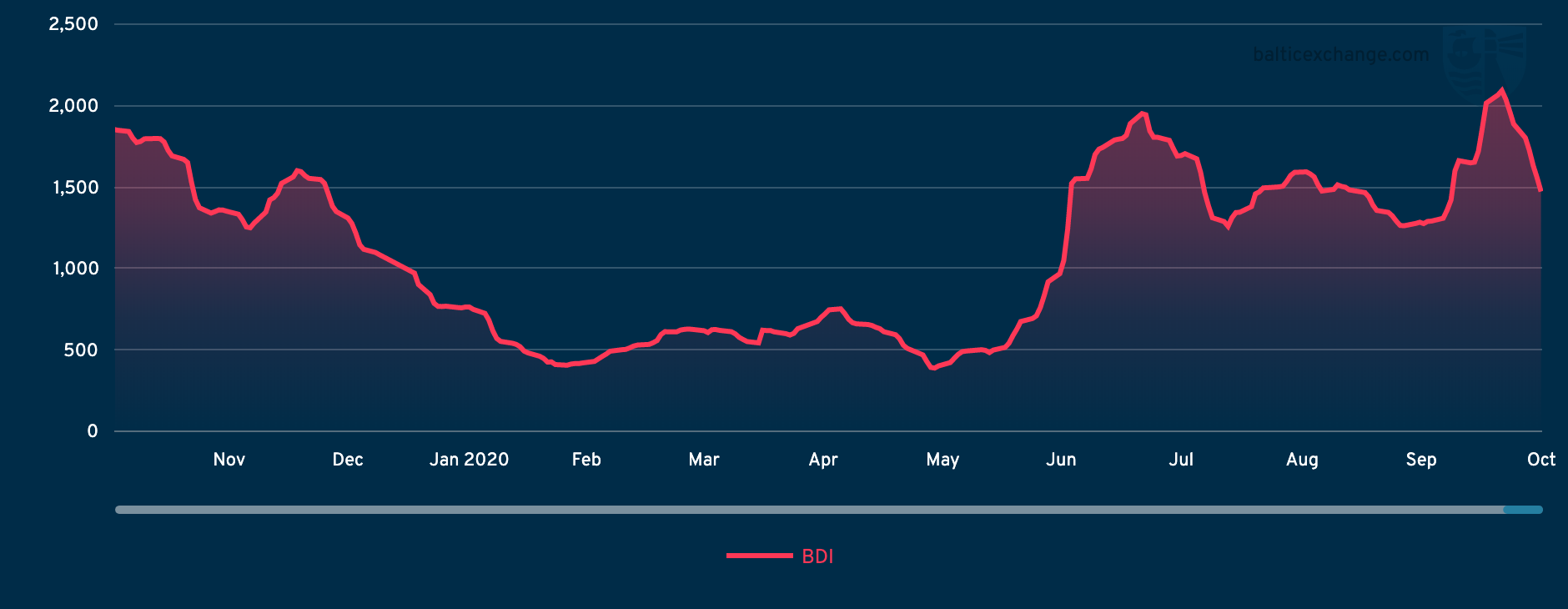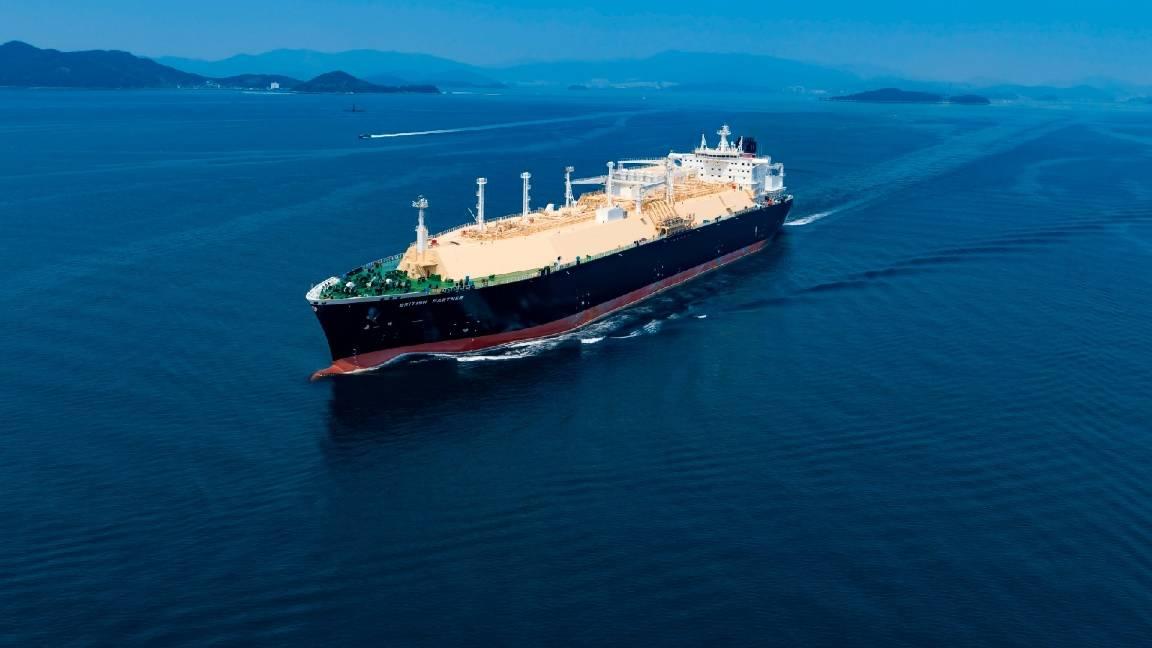BEIJING, Oct. 20 (Xinhua) -- The Baltic Exchange has published its weekly report of the dry and tanker markets for October 12-16, 2020 as below:
Capesize
The Capesize market kept up a constant precipitous fall in values this week. Opening at $29,479, the Capesize 5TC has closed the week at $19,952, a drop of almost 30pct. The Atlantic has been the most affected of the basins, yet this is likely because it had further to fall. As expected, activity was low throughout the declining week with owners able to bide their time to take large bites out of rates every time they fixed. The Brazil to China C3 declined at an increasing rate, as it lost $3.592 to close the market down at $16.53 by weeks end. The Atlantic market was very low throughout the week and the negative sentiment of the wider market pushed the Transatlantic C8 down to $22,475. The Pacific Basin had little to stop the C5 drop. It settled the week at $7.668 breaking hopes of a quick rebound. While rates have lowered, earnings still remain in the respectable high teens level. The coming week will be telling on whether Q4 holds any further prospects or whether the market should start prepping itself for the coming Q1.
Panamax
Little sign of cheer this week as Panamax rates came under severe pressure. In particular throughout the Atlantic basin as the supply/demand plot turned in favour of the charterers, who for the most part were able to pick off tonnage at will as the count increased. The US gulf numbers drifted as committed tonnage and ballasters broadly frustrated the market here. Elsewhere, activity from EC South America was modest - at best. In Asia, it was a tale of two divides with the North region at the beginning of the week trending firm and the south appearing weak with a distinct lack of minerals ex Australia. However, come mid-week the axis had tipped in favour of a strong southern region with a glut of Indonesian stems surfacing against a tighter tonnage count. NoPac rates drifted from $13,000, getting fixed on 82,000dwt delivery Republic of Korea midweek to a median rate today pegged at around $12,000.
Supramax/ Ultramax
A rather lacklustre week for the BSI, which remained flat at the beginning of the week. But as the week ended, slight negative movement appeared. Little in the way of period activity was reported with both owners and charterers unwilling to commit. From the Atlantic, demand remained from Mediterranean and Continent. A 55,600dwt fixing delivery Casablanca for a trip via Continent redelivery east Mediterranean with scrap at $15,500. From the US Gulf, rate remained steady especially for petcoke runs to India. A 57,000dwt fixing at $24,000 redelivery west coast India. Otherwise east coast South America remained rather flat with limited fresh enquiry. From Asia, it was a mixed bag. A 55,000dwt seeing $10,000 for a north Pacific round redelivery Indonesia. Further south, a 56,000dwt fixed delivery Kosichang trip via Indonesia redelivery Vietnam in the mid $9,000s. The Indian Ocean remained steady, a 55,000dwt fixing delivery South Africa trip redelivery Pakistan at $11,750 plus $175,000 ballast bonus.
Handysize
Brokers suggested rates for the Continent market remained firm compared with the Mediterranean, whilst tonnage in the US Gulf is starting to build up with limited fresh cargoes. However, the direction of east coast South America was not clear with the bigger-sized Handysize vessels again being more competitive. Some period activity included a 38,000dwt delivery Setubal fixing four to six months at $12,900 with redelivery in the Atlantic. A 39,000dwt open Otranto was failed on subjects for the same period at similar level. On the time charter front, a 38,000dwt delivery Italy was fixed for a trip via the Black Sea to east coast South America at $12,000. A 30,000dwt and a 37,000dwt, both delivery in the US Gulf, was fixed for a trip to east coast South America at $13,000 and low $14,000s respectively. Trips from east coast South America paid $10,000 on a 34,000dwt to UK/Continent and $8,750 on a 37,000dwt to US east coast.
Clean
The start of the week saw rates in the 75,000mt Middle East Gulf/Japan trade ease two plus points to WS72.5, and charterers have continued to force owners into further concessions with the market here now in the high WS60s. It was a similar story in the LR1 trade, with the market softening 2.5 points to WS70 and WS67.5 was agreed on a ship with last cargo UMS. For owners plying the 37,000mt UKC/USAC trade, it has been another difficult week with rates now hovering around WS70. This represents a drop of close to five points here. It was no better in the backhaul trade, with limited enquiry. A 38,000mt from US Gulf to UKContinent was fixed at WS55, in contrast to low WS60s at the start of the week. The US Gulf/Brazil trade followed suit with the market losing 12.5 points to sit now at WS77.5. The clean market cross Med was stagnant at WS70.
VLCC
A slight improvement was seen this week on certain routes in this sector. A voyage of 280,000mt to USG via the Cape/Cape routing remains assessed at a shade above WS17. However, 270,000mt to China now stands at just shy of WS30, up three points from a week ago. In the Atlantic, rates for 260,000mt West Africa to China remain unchanged at WS30/31. As for 270,000mt USG to China, rates remain around the $4.7-$4.8m mark.
Suezmax
Rates for 135,000mt Black Sea/Med eased a couple of points to WS42.5 level, whilst 130,000mt Nigeria/UKContinent was fixed a few times this week and charterers pushed rates down another point or two to WS30. In the Middle East market, there is still no optimism for owners and rates for 140,000mt Basrah/Med are now assessed at around WS12.5-13 - down just over a point from last week.
Aframax
The 80,000mt Ceyhan/Med market, for the fourth week running, remained stuck at WS57.5. In Northern Europe rates for 80,000mt Cross-North Sea initially lost 2.5 points to WS67.5 but recovered to WS70. Rates for 100,000mt Baltic/UKC gained five points to WS40, with some upward pressure still being applied.
Across the Atlantic, rates for 70,000mt Carib/USGulf remained pegged at WS45, while 70,000mt USG/UKC saw some fixing activity with rates holding around WS42.5, which is up two points from last week.
Headquartered in London and a subsidiary of the Singapore Exchange (SGX), the Baltic Exchange publishes a range of indices and assessments which provide an accurate and independent benchmark of the cost of transporting commodities and goods by sea. These include the Baltic Dry Index (BDI), the dry bulk shipping industry's best known indicator. Published daily since 1985, this provides a snapshot of the daily spot market earnings of capesize, panamax and supramax vessel types on the world's key trading routes.

Chart shows Baltic Dry Index (BDI) during Oct.17, 2019 to Oct.16, 2020
In March 2018 the BDI was re-weighted and is published using the following ratios of timecharter assessments: 40 percent capesize, 30 percent panamax and 30 percent supramax. The information is provided by a panel of international shipbrokers.
(Source: The Baltic Exchange, edited by Niu Huizhe with Xinhua Silk Road, niuhuizhe@xinhua.org)




 A single purchase
A single purchase









